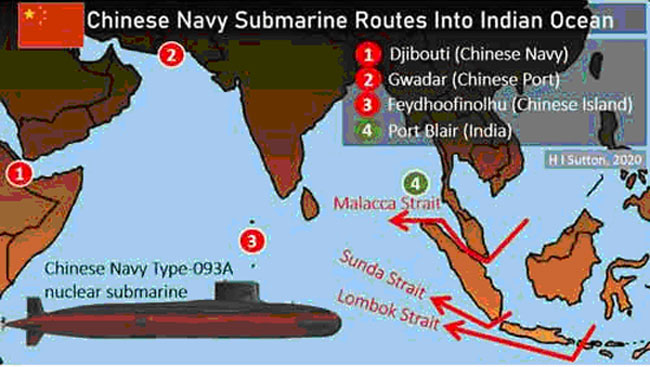Chinese Navy Submarines Could Become A Reality In Indian Ocean
Saturday, June 27, 2020
The Chinese Navy is rapidly pursuing global capabilities. A key area of future operations may be the Indian Ocean. Chinese submarines in particular could have a strategic impact if they were roaming those waters. From China’s standpoint this would protect vital sea lanes that will be vulnerable in any war. Naturally many of the world’s navies would be concerned if this were the case. Chief among them is the Indian Navy, which currently has the largest submarine fleet in the South Asia region.
Concern about China’s naval expansion is a hot topic on the world stage. The U.S. Navy is increasingly pivoting towards Asia. Speaking at the Brussels Forum virtual conference on June 25, Secretary of State Mike Pompeo referenced the Chinese Communist Party’s “threats to India” and other countries in Asia. “We are going to make sure that we are postured appropriately to counter the PLA.” (People’s Liberation Army, which includes the Chinese Navy.)
But much of the attention is on the South China Sea, where Beijing has made extensive territorial claims. The Indian Ocean theater seems less of a focus, at least in the public’s eye. For India, however, the threat seems very real. Chinese submarines have paid port calls in Pakistan and Sri Lanka in recent years.
During peacetime Chinese submarines would be expected to enter the Indian Ocean through the Strait of Malacca. This should be done on the surface, which makes their presence obvious. China might still do it to send a message, but it is of limited utility in an operational setting where submarines want to hide their presence.
In wartime, Chinese submarines might slip through the Sunda Strait or Lombok Strait. These pass between the chain of Indonesian that separate the Pacific and Indian Oceans. One advantage over the Malacca Strait, which runs past Singapore, is that it would deliver the submarines to the deep water of the eastern Indian Ocean. From there they could take less obvious routes to their targets.
The Sunda Strait would be the shortest route, but it is very shallow at its eastern end so the deeper Lombok Strait might be preferred. There a submerged passage is likely considered feasible to the Chinese Navy.
Once through into the Indian Ocean, the submarines could get rearmed or resupplied without having to return to China. The Chinese Navy has already built a base in Djibouti on the Horn of Africa. Even if the submarines themselves did not call in to the port, which would be closely monitored, vessels could operate from there to carry out at-sea replenishment.
And there is another Chinese port under construction at Gwadar in Pakistan. Work on an extension of that port, which may include a Chinese naval base, appears to be imminent. Gwadar has an advantage in that it is connected by land to China so supplies would not have to go by sea.
If China were to create a permanent Indian Ocean squadron, its natural bases would be Gwadar and Djibouti. There is also the small island of Feydhoofinolhu in the Maldives, which China is developing as a resort. Planners will be concerned that it could act as a support base or monitoring station in some scenarios.
For its part, the Indian Navy is also growing its capabilities and modifying its operating patterns to counter the threat. There is evidence that it has been testing its ability to forward deploy submarines to the Andaman and Nicobar Islands. This could hold the key to monitoring submarine activity in the Strait of Malacca.
At the same time, the Indian Navy’s U.S.-supplied P-8I Neptune aircraft are updating India’s anti-submarine reach in to the Indian Ocean and Arabian Sea. Together with the surface navy and the submarine force, this could hope to track Chinese submarine movements.
But in the vastness of the ocean this could be challenging. Even though China’s submarines may not be as quiet as their Western equivalents, they have a natural stealth advantage. Even very old submarines pose a serious threat that cannot be ignored in wartime. So for India it will be critical how quickly it can react to a more pervasive Chinese Navy presence in the Indian Ocean.
Courtesy: Opera News/ Forbes

